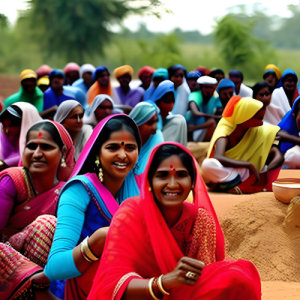This program has been at the vanguard of what India’s shifting rural landscape may hold
The Mahatma Gandhi National Rural Employment Guarantee Act (MNREGA) is a historic legislation in India that intends to provide rural households with job opportunities and security for their means of subsistence. India’s ongoing rural suffering, poverty, and need for inclusive progress are the foundation of MNREGA’s historical development. The following summarizes MNREGA’s whole history, from its founding to the present:
History and the pilot (2005–2006)
India experienced enormous issues with poverty, unemployment, and rural hardship during the close of the 20th century. Seasonal unemployment plagued rural people, particularly those who were poor and lacked access to regular work options. The National Rural Employment Guarantee Scheme (NREGS) was introduced by the Indian government as a trial program in 200 of the most underdeveloped districts in the nation as a solution to these problems.
MNREGA’s passage (2005–2006)
As a result of the NREGS pilots’ effectiveness and beneficial effects, a notice was published on September 7, 2005, in accordance with section 6(1) of the Mahatma Gandhi National Rural Employment Guarantee Act (MNREGA), 2005, which says that the Center may define salary rates for its beneficiaries by notification. The Act bears the name of Mahatma Gandhi, a well-known figure in the Indian freedom struggle who promoted social and rural development. The purpose of this legislation is to provide every rural family willing to do unskilled manual labor a legal guarantee of at least 100 days of employment in a fiscal year.
Goals of the MNREGA
MNREGA’s main goals included securing rural households’ sources of income, developing sustainable assets and infrastructure in rural areas, preventing rural-urban migration by creating local employment opportunities, empowering rural women, and promoting decentralization and local self-governance.
Major MNREGA clauses
According to MNREGA, qualified rural households may request work within 15 days after applying, and the government was required to comply within that time frame. The Act did not require payment of wages below the state-set minimum wage, but it did require compensation in the event of a delay. Additionally, it aimed to increase the percentage of women in the workforce to at least one third.
Mechanisms for implementation and financing
The Ministry of Rural Development, Government of India, implemented MNREGA in cooperation with state governments. Gram Panchayats (local self-government at the village level) were crucial in the development, execution, and monitoring of grassroots initiatives. The MNREGA was funded by the federal government, and the center and the states split the costs. At first, the states were responsible for 25% of the expenditures while the federal government covered 100% of the labor costs and 75% of the material costs. Later on, the split was modified to 60:40.







